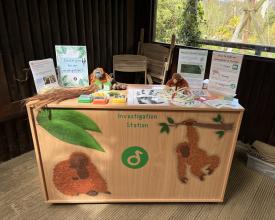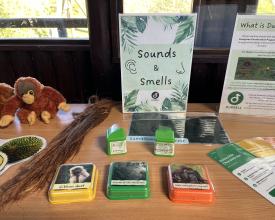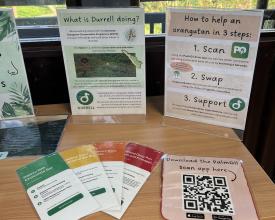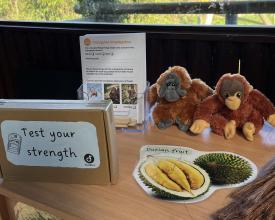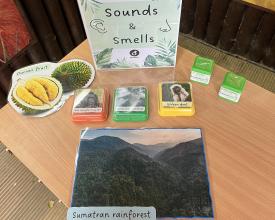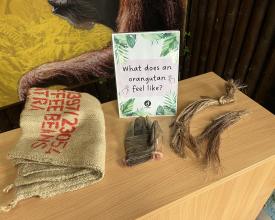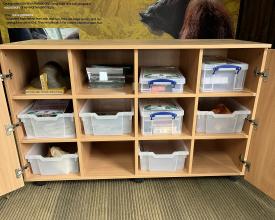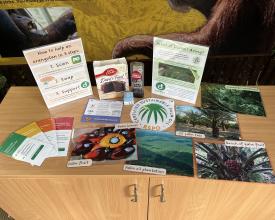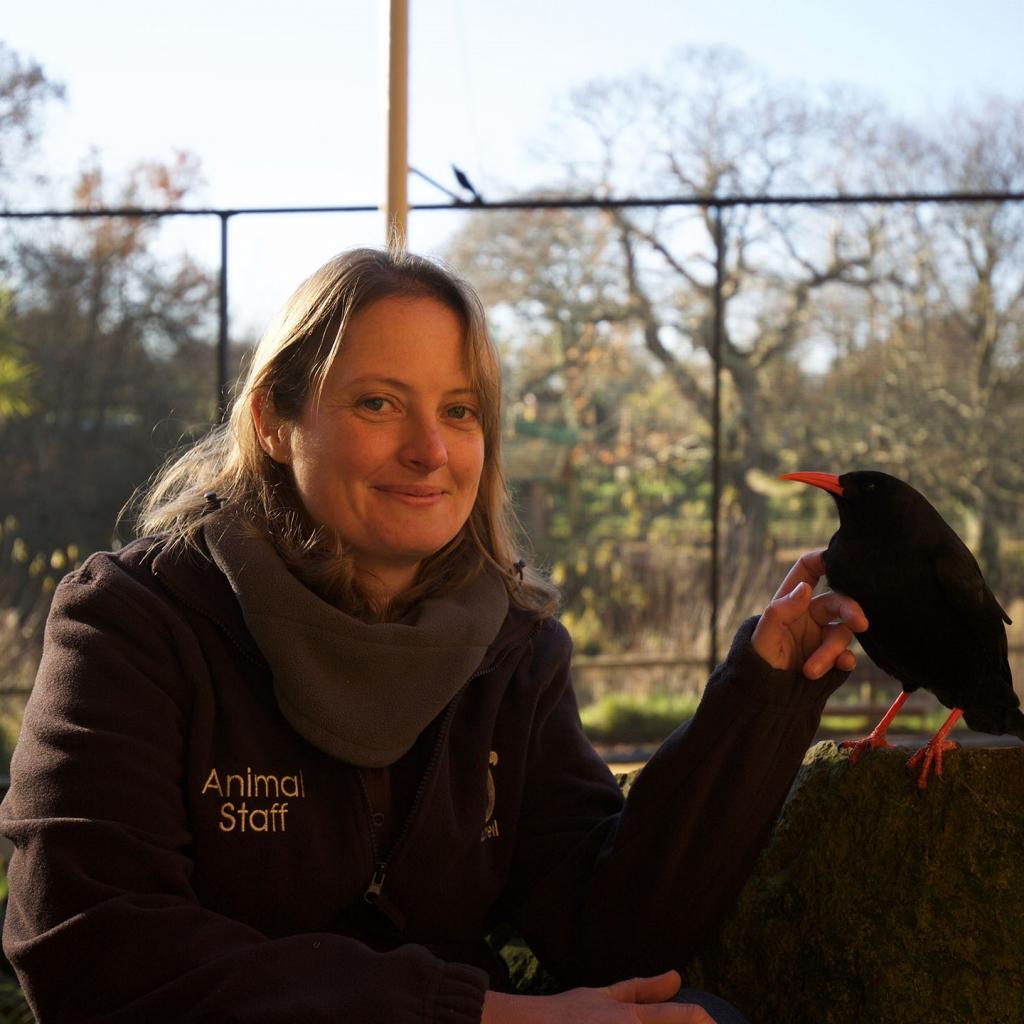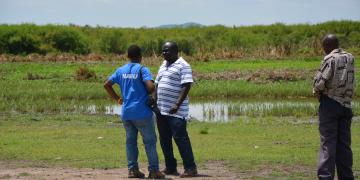
The Investigation Station: An interactive, sensory-based approach to reconnecting zoo visitors with nature
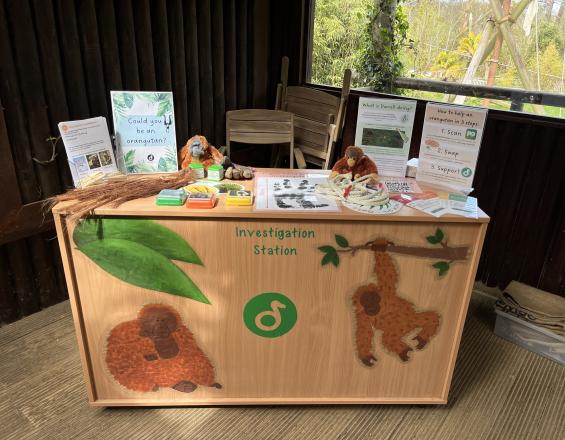
Research shows that people are becoming increasingly disconnected with nature and are, therefore, less likely to adopt pro-environmental behaviours. To inspire Jersey Zoo visitors to take up simple, but effective, conservation actions we developed an 'Investigation Station'. The staff and volunteer-led station consists of various interactive, sensory-based items and activities to educate visitors about Sumatran orangutans and promote sustainable palm oil use. Each activity also incorporated at least one of the five Nature Connection Pathways (Sensory, Beauty, Emotion, Meaning, Compassion) to, hopefully, reconnect visitors with nature and our orangutans. During the Easter school holidays, alone, the station opened for 56 hours, engaged 2,152 visitors (21.7% of admitted visitors), recruited 12 volunteers to help run it and achieved a mean visitor dwell time of 4m57s.
Contexte
Challenges addressed
Social challenges
- The rise in digital media is causing many people to become disconnected with nature and, therefore, less likely to adopt pro-conservation behaviours.
- The growing knowledge-action gap, whereby people are aware of ecological crises but are unwilling to act, is a further barrier preventing the success of many conservation efforts.
Environmental challenges
- Deforestation due to increased agricultural expansion is a leading cause of biodiversity loss resulting in many species, such as the Sumatran orangutan, becoming critically endangered.
- Unsustainably sourced palm oil has devastating impacts on ecosystems and biodiversity, which will only increase with the growing demand for palm oil.
Emplacement
Traiter
Summary of the process
By integrating the stories of keepers and volunteers, who work closely with the species on a daily basis, the Station offered visitors a unique insight into the lives of Jersey Zoo's orangutans. Collaborating [1] in this way also meant the keepers' ideas for resources and activities demonstrating novel husbandry and enrichment techniques could also be incorporated. In turn, this helped boost the interactivity and engagement of the Station's resources [2]. Having access to biofacts at the Station also significantly helped draw visitors in, both young and old, which then led to further conversations about conservation actions.
The sensory-orientated resources also acted as conversation starters and boosted visitors' understanding and connection to the orangutans. This was complemented further by staff and volunteers tailoring the resources [3] to the audience's interests and curiosity. Finally, the simplified conservation actions [4] meant visitors who now felt inspired and connected to the orangutans could leave feeling empowered and able to make a difference.
Building Blocks
Collaborative planning
Throughout the development and delivery of the Station, mammal keepers at Jersey Zoo were consulted regularly to ensure the resources were both accurate and not disruptive to the animals (e.g. the sound button recordings). This collaboration also allowed the keepers, who were enthusiastic of the idea, to share details of their daily routines and anecdotes of the orangutans which could then be incorporated into the Station's storytelling element. The keepers also helped supply materials and biofacts to use at the Station, along with ideas on how to use them effectively. These elements, including some real orangutan teeth, significantly increased the attraction power and impact of the Station. Feedback from volunteers and those running the Station was also encouraged to ensure the resources met the needs of the educators, as well as the audience.
Enabling factors
- Building strong relationships with the animal keepers, volunteers and other contributors for sharing ideas, information and feedback
- Working closely with the appropriate keepers to ensure resources are factual and appropriate
- Collecting anecdotes from keepers and volunteers to enhance storytelling and emotional connections between visitors and the orangutans at the zoo
- Encourage feedback from volunteers, with appropriate suggestions being actioned quickly
Lesson learned
Before running the Station, each volunteer was invited to a training session and provided with a handbook with anecdotes and information on the history of orangutans at Jersey Zoo. This training worked well to ensure all educators had a baseline knowledge. However, having a shorter, easily accessible fact sheet with information such as orangutan's habitat, lifespan and key facts about the zoo's individuals proved to be a necessary addition to the Station, as suggested by the volunteers.
Interactive & sensory-based resources
The different sensory-based elements of the Investigation Station offer alternative pathways for visitors to access conservation messages, away from traditional signage. Interactive methods, such as this, allows information to be conveyed in a memorable and, therefore, more impactful way. It also meant visitors with a variety of Special Educational Needs and Disabilities (SEND) were still able to engage with the station and learn something new.
Enabling factors
The Station's resources covered most of the five human senses, with each resource conveying a different educational message. Additionally, the sensory items were all relatively easy to obtain or make, meaning production costs remained low.
Touch
- Worn gardening glove (to represent an orangutan’s skin texture)
- Combed out rope (to mimic hair)
Smell
- Smell cubes (e.g. durian fruit)
Hearing
- Sound buttons with relevant recordings (e.g. orangutan long call)
Sight
- Coloured photos (e.g. to show orangutan's habitat and the impact of palm oil plantations)
Lesson learned
Despite the consideration for visitors with SEND, some children with autism found the sounds and smells to be overwhelming. In these cases, we removed these elements from the Station and used different resources to demonstrate our points. Having the staff member or volunteer present at the Station meant we were able to quickly adapt the Station to each visitor's learning needs.
Tailoring of resources
The resources at the Station are organised into five themes: 'Sounds & Smells', 'How you can help', 'Could you be an orangutan?', 'What does an orangutan feel like?' and 'Orangutan Observations'. However, the flexibility of the resources means they can easily be mix-and-matched and tailored to both the audience's curiosity and the staff/volunteer's expertise. That is, no resource is dependent on any other. Furthermore, resources from each of the themes can easily be connected together.
For example, the armspan ropes, handprint and sound buttons could be combined to talk about orangutans' arboreal lifestyle and how they have adapted to their habitat. This can then lead to a conversation about the destruction of their habitat and the need for sourcing sustainable palm oil. Alternatively, the handprint and grip strength dynamometer can be used to create a sense of awe and subsequently a memorable impression on the visitor.
Enabling factors
- Independent resources which can be connected via a meaningful, awe-inspiring story
- Resources relatable to your audience (e.g. the orangutan's hand print can be compared with a visitors' own)
- Staff / volunteers leading the Station can change the arrangement of resources depending on their strengths and audience
- New staff / volunteers are trained on what resources are on offer and a variety of ways they can use them effectively
Lesson learned
Clear organisation is needed when storing the resources to ensure each volunteer / staff member can set-up quickly and easily retrieve relevant resources when talking to a visitor. We also found that constant staffing of the Station can be costly, in terms of time, and so may not always be possible, especially if volunteers are in short supply.
Simplified conservation actions
A leading cause for people not adopting pro-environmental behaviours is low self-efficacy. That is, they do not believe they can employ the action themselves. Therefore, at the Station we simplified key conservation actions which UK and Jersey consumers can do to support wild Sumatran orangutans. One of these steps was to download the PalmOil Scan app, which enables consumers to identify companies actively sourcing sustainable palm oil. This then allows people to make informed decisions as to which products they buy, and as a result which companies they support.
Enabling factors
- Breaking down conservation actions in to easy, achievable steps
- Providing opportunities to see the conservation behaviour in action (e.g. provision of empty packaging with barcodes to scan using the app)
- Provide an easy way for audiences to get involved (e.g. provide a QR code for downloading an app)
- Staff/volunteers present allowed visitors to ask specific questions and solidify their understanding
Lesson learned
Where we were hosting the Station there was limited access to Wi-Fi and mobile signal and so downloading the app, especially for overseas visitors, sometimes proved difficult. Setting up a portable network provider for visitors to connect to could avoid this issue. Alternatively, leaflets with information and links to the app for visitors to photograph or take away with them may be a more practical solution for visitors to take action at a more convenient time. However, this would make evaluating the number of visitors successfully downloading the app difficult.
Impacts
Since the Investigation Station opened in April 2025:
- 2,594 visitors have been engaged
- 14 trained volunteers have assisted running the Station
- Average dwell time is 4m24s
- Numerous visitors returned to the station with new family and friends, eager to show-off their new knowledge
- Many positive comments from visitors, volunteers and zoo staff were made
- Visitors of all ages, learning abilities and languages were observed accessing the Station's resources
Due to the success of the Orangutan Investigation Station, we are now working on developing more for different species at the zoo. This will further demonstrate the project's replicability.
Beneficiaries
Jersey Zoo visitors
Jersey Zoo's staff and volunteers
Sustainable palm oil farmers
